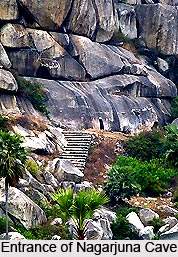 Nagarjuna caves are located on the Nagarjuni hills which are 41 kms from Bodh Gaya and 36 kms north of Gaya. The historic Nagarjuni hills are situated near the banks of river Mahanadi at Sirpur in the Mahasamund district. Here Buddhist religious principles were practiced. The Nagarjuna caves bear inscriptions of Ashoka and Dasaratha which are helpful in determining the dates of construction and religious affiliations of the residents. Nagarjuna group include Gopi, Vadathi and Vapuiya.
Nagarjuna caves are located on the Nagarjuni hills which are 41 kms from Bodh Gaya and 36 kms north of Gaya. The historic Nagarjuni hills are situated near the banks of river Mahanadi at Sirpur in the Mahasamund district. Here Buddhist religious principles were practiced. The Nagarjuna caves bear inscriptions of Ashoka and Dasaratha which are helpful in determining the dates of construction and religious affiliations of the residents. Nagarjuna group include Gopi, Vadathi and Vapuiya.
Architecture of Nagarjuna Caves
The Gopi has large chambers. This cave can be approached by flight of steps. This cave contains several important inscriptions. Some of them testify that son of Ashoka - Dasaratha has devoted these caves to Ajivika. Therefore these structures might be some 50 years younger than caves at Barabar Hills. The cave is 12.3 m long and 5.8 m wide. Both ends of the chamber are semi-circular. The Roof is vaulted, up to 3.2 m high. The cave has polished walls and floor. It also contains an Anantavarman inscription. It records the installation of Katyani statue in the cave.
The second cave is to the north of Nagarjuna Cave also known as Mirza Mandi (house of Mirza). There is a dry well thus it is also known as Vahiyaka, Vapuiyaka Kubha, Vapya-ka-Kubha or cave of the well. This cave consists of several inscriptions.
Through an enormous crevice one can reach the third cave - Vedathika Kubha (Vadathi ka Kubha, Vadathi ka Kubha). These caves were created for Ajivika. Some structural stupas might have existed here.
Common Characteristics of Nagarjuna Caves
These caves have rectangular Ante chambers with or without attached circular chambers at the back. In the Gopi cave there is a fusion of rectangular and circular ante chamber in order to create an integrated plan that has an apsidal end. Gopi cave has a quadrennial vault. The walls of Vadathi spring directly from the floor. All these caves have plain interiors and polished inside. Contemporary timber architecture is evident in the design of Vadathi caves suggesting the presence of wooden screen walls and doors. All these caves have slanting door jambs. Most these caves can be entered from the sides but some have frontal entries.
Literary evidence from the inscriptions inside the caves shows that Nagarjuna visited this place in the 2nd Century B.C. following whish many famous monks and Buddhists visited the cave. It is also marked that Buddha also meditated in one of the caves here in the 6th Century B.C. As Dalai Lama considers Nagarjuna his master, he has decided to meditate in the cave where his master did during the Satvahana rule.






